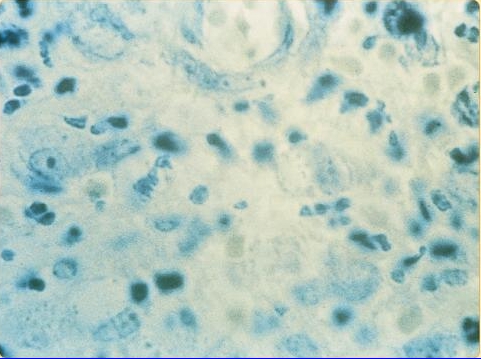In late October 2021, accounts of a “flesh eating” sexually transmitted infection circulated in international media publications when it was reported that cases were on the rise in the United Kingdom.
An article published on Oct. 21 by Birmingham Live, a tabloid newspaper based in England, reported that doctors were “warning” of the infection, describing it as “terrifying” because of its ability to “eat human flesh.”
“Though donovanosis cases remain relatively rare when compared with other sexually transmitted infections (STIs) and diseases (STDs), they have been steadily rising and pose a genuine risk to public health,” read the Birmingham Live article.
And in the days that followed, the claim took off like a bacterial infection as media outlets, including USA Today and Fox News, contributed to concerns surrounding the prevalence of the disease both in the U.K. and in the U.S. But many headlines and social media posts were more alarmist than perhaps was warranted.
While it is true that such an STI exists, infection rates are still rare.
Donovanosis, or granuloma inguinale, is described by the Centers for Disease Control and Prevention (CDC) as a “genital ulcerative disease” caused by a bacterium called Klebsiella granulomatis.
“The disease occurs rarely in the United States; however, sporadic cases have been described in India, South Africa, and South America,” wrote the CDC. “Although granuloma inguinale was previously endemic in Australia, it is now extremely rare.”

Typically spread through vaginal or anal sex, infection is characterized by painless sores or lesions on the genitals that exhibit a “beefy red appearance” that can bleed. (You can view images of these ulcers here, here, and here. Fair warning, they are graphic.) These “snake-like” lesions can also progress outside of the genital area to the pelvis, organs, bones, or mouth and can also develop secondary bacterial infections that may coexist with other sexually transmitted pathogens. Infection is difficult to culture, and diagnosis typically requires that a medical professional collect a biopsy from the ulcer or a tissue smear and look at it under a microscope.
Donovanosis is more common in places like India, Brazil and New Guinea. And while it may be on the rise in the U.K. and U.S., it is still less common than other bacterial STIs like gonorrhea, chlamydia, and syphilis. In fact, the U.S. National Library of Medicine estimates that there are about 100 cases reported each year, most of which occur in people who have traveled to or are from places where the disease is common, mostly in people between 20 and 40 years old. As The Washington Post reported, those numbers were equally as low in the U.K. Between 2016 and 2020, there were between 18 and 20 cases detected in England annually.
“Eighteen infections were logged in 2020, down from 30 in 2019, as widespread social distancing curbed its spread, along with those of other STIs,” wrote the publication.
Though rare, infection can be chronic, and relapse can occur between six and 18 months after seemingly successful treatment, which typically involve a prescription of antibiotics like azithromycin or doxycycline.
But because donovanosis is more common in low-income nations, the science surrounding infection, transmission, and treatment remains lacking.
“Although the disease has been described for more than a century, it is often overlooked due to its geographical distribution and low incidence. Therefore, it is not surprising that there are few published data on its incidence, even in endemic areas,” wrote Brazilian Professor of Dermatology Walter Belda Junior in a 2020 issue of the Brazilian Society of Dermatology’s scientific journal, Anais Brasileiros de Dermatologia.
The Birmingham Live article did not give an explanation as to why cases of donovanosis were rising, but a 2021 article published in the online educational medical library StatPearls noted that incidence had been decreasing worldwide “most likely due to the realized role in HIV transmission.” HIV infection prolongs the healing time of donovanosis and because ulcers often bleed easily, they increase the risk of also becoming infected or transmitting HIV. As global health initiatives focused on eradicating HIV in the last several decades, cases of donovanosis have subsequently also largely decreased around the world.
Experts recommend that a person diagnosed with donovanosis avoid contact and sexual activity until the sores are healed. If a person had sex with a diagnosed patient within 60 days before onset of symptoms, they should be examined and given treatment.
Sources
“A ‘Flesh Eating’ STI Causing ‘beefy Red’ Sores Is Becoming More Common. Should Americans Worry?” USA TODAY, https://www.usatoday.com/story/news/health/2021/10/25/flesh-eating-sti-donovanosis-becoming-more-common-uk/6171385001/. Accessed 26 Oct. 2021.
Arif, Tasleem, and Mohammad Adil. “Donovanosis in a Human Immunodeficiency Virus-Positive Female.” Indian Journal of Sexually Transmitted Diseases and AIDS, vol. 41, no. 1, 2020, pp. 131–33. PubMed
Central, https://doi.org/10.4103/ijstd.IJSTD_18_17.
Belda Junior, Walter. “Donovanosis.” Anais Brasileiros de Dermatologia, vol. 95, no. 6, 2020, pp. 675–83. PubMed Central, https://doi.org/10.1016/j.abd.2020.07.002“Donovanosis.” Anais Brasileiros de Dermatologia, vol. 95, no. 6, 2020, pp. 675–83. PubMed Central, https://doi.org/10.1016/j.abd.2020.07.002.
“Did Controversial AZT Treatment Kill More Patients than AIDS in ’80s, ’90s?” Snopes.Com, https://www.snopes.com/news/2021/09/21/did-azt-kill-more-patients-than-aids/. Accessed 26 Oct. 2021.Donovanosis (Granuloma Inguinale): MedlinePlus Medical Encyclopedia. https://medlineplus.gov/ency/article/000636.htm. Accessed 26 Oct. 2021.
File:SOA-Donovanosis-Male.Jpg - Wikimedia Commons. https://commons.wikimedia.org/wiki/File:SOA-Donovanosis-male.jpg. Accessed 26 Oct. 2021.
https://commons.wikimedia.org/wiki/File:SOA-Donovanosis-male.jpg. Accessed 26 Oct. 2021.
“‘Flesh-Eating’ STD That Causes ‘Beefy Red’ Sores Is Spreading in UK.” New York Post, 24 Oct. 2021, https://www.foxnews.com/health/flesh-eating-std-spreading-uk.
Frysh, Paul. “What Is Donovanosis?” WebMD, https://www.webmd.com/sexual-conditions/what-is-donovanosis. Accessed 26 Oct. 2021.
Granuloma Inguinale (Donovanosis) - STI Treatment Guidelines. 13 July 2021, https://www.cdc.gov/std/treatment-guidelines/donovanosis.htm.
Granuloma Inguinale/Donovanosis | Immigrant and Refugee Health | CDC. 8 Nov. 2019,
https://www.cdc.gov/immigrantrefugeehealth/guidelines/domestic/sexually-transmitted-diseases/granuloma-inguinale-donovanosis.html.
Purves, Robbie. “Doctors Warning as ‘flesh-Eating’ STI Hits UK.” BirminghamLive, 21 Oct. 2021, https://www.birminghammail.co.uk/news/health/what-donovanosis-flesh-eating-sti-21924441.
Santiago-Wickey, Jenna N., and Brianna Crosby. “Granuloma Inguinale.” StatPearls, StatPearls Publishing, 2021. PubMed, https://www.ncbi.nlm.nih.gov/books/NBK513306/.
“Granuloma Inguinale.” StatPearls, StatPearls Publishing, 2021. PubMed, https://www.ncbi.nlm.nih.gov/books/NBK513306/.
“Sexually Transmitted Infections (STIs): Migrant Health Guide.” GOV.UK, https://www.gov.uk/guidance/sexually-transmitted-infections-stis-migrant-health-guide. Accessed 26 Oct. 2021.
TikTok. https://www.tiktok.com/@dr.karanr/video/7022671507700714758?is_copy_url=1&is_from_webapp=v1&lang=en. Accessed 26 Oct. 2021.
“What Is Donovanosis? So-Called ‘Flesh-Eating’ STI Sparks Fears in Britain, but Case Numbers Are Low.” Washington Post, 26 Oct. 2021, https://www.washingtonpost.com/world/2021/10/26/donovanosis-flesh-eating-sti-symptoms/.
